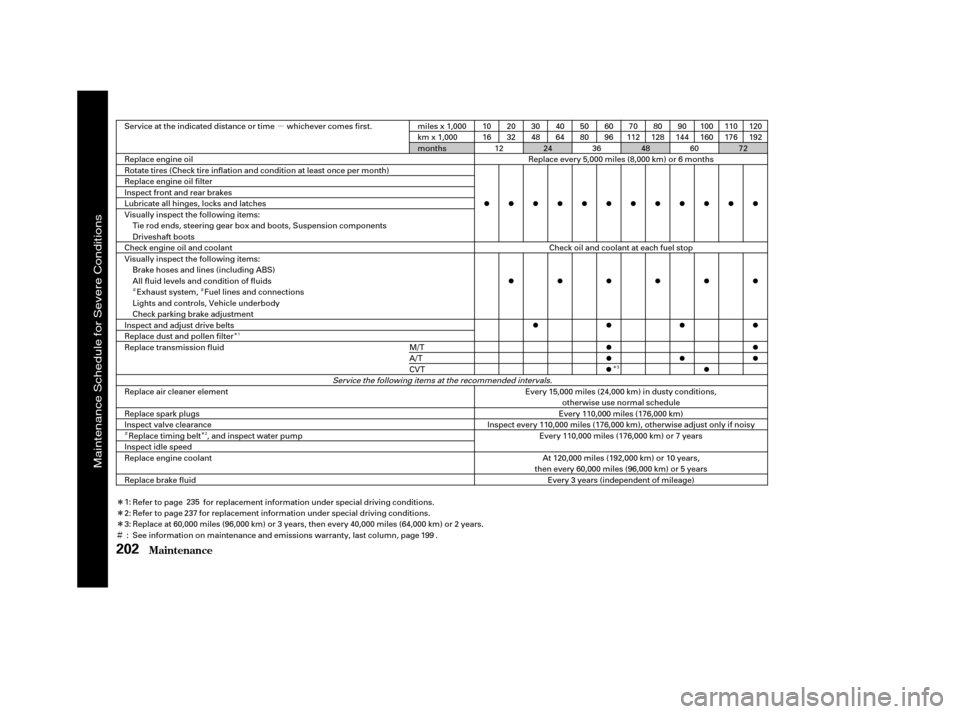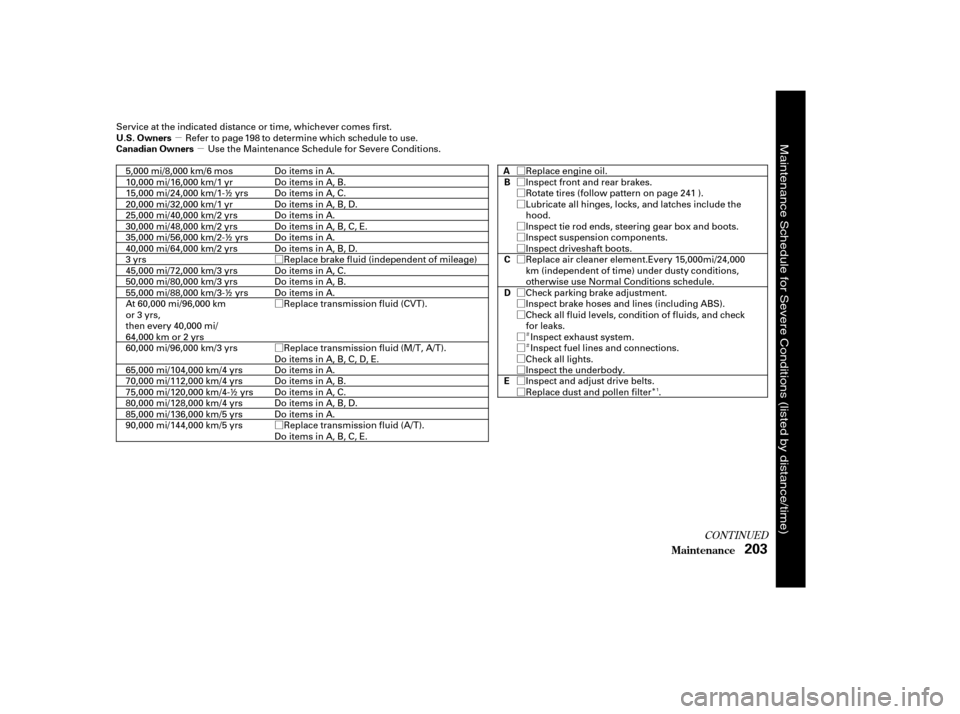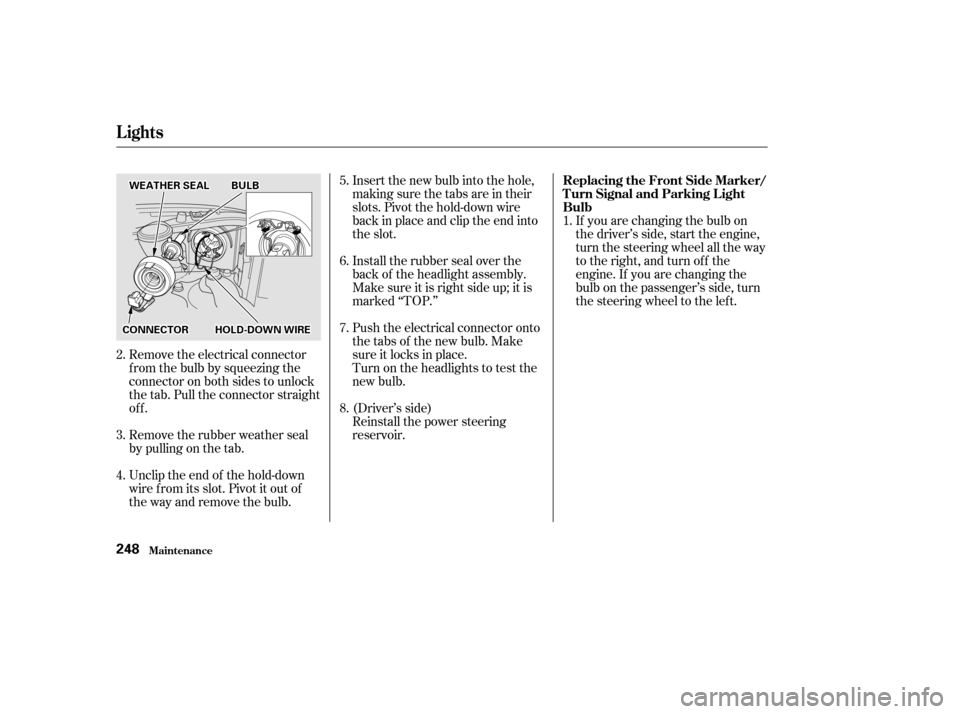Page 194 of 319

This section also includes
Maintenance Schedules f or normal
driving and severe driving conditions,
a Maintenance Record, and instruc-
tions f or simple maintenance tasks
you may want to take care of
yourself .
If you have the skills and tools to per-
f orm more complex maintenance
tasks on your Honda, you may want
to purchase the Service Manual. See
page f or inf ormation on how to
obtain a copy, or see your Honda
dealer.
This section explains why it is
important to keep your car well
maintained and to f ollow basic
maintenance saf ety precautions.
......................
Maintenance Saf ety . 196
.
Important Safety Precautions . 197
.................
Maintenance Schedule . 198
...
Required Maintenance Record . 205
.......
Owner Maintenance Checks . 207
..............................
Fluid Locations . 208
......................................
Engine Oil . 209
..................................
Adding Oil . 209
....................
Recommended Oil . 209
..............................
Synthetic Oil . 210
....................................
Additives . 210
.....
Changing the Oil and Filter . 211
.............................
Cooling System . 213
............
Adding Engine Coolant . 213
.......
Replacing Engine Coolant . 215
....................
Windshield Washers . 219
.......................
Transmission Fluid . 220
Automatic .........................
Transmission . 220
5-speed Manual .........................
Transmission . 222
................
Brake and Clutch Fluid . 223
............................
Brake System . 223
...........................
Clutch System . 223
..............................
Power Steering . 224
.....................
Air Cleaner Element . 225 ....................................
Hood Latch . 226
....................................
Spark Plugs . 227
..............................
Replacement . 227
............................
Specif ications . 229
...........................................
Battery . 230
.................................
Wiper Blades . 232
..............
Air Conditioning System . 234
..................
Dust and Pollen Filter . 235
.....................................
Drive Belts . 237
....................................
Timing Belt . 237
...............................................
Tires . 238
......................................
Inf lation . 238
Recommended Tire Pressures ...........
f or Normal Driving . 239
..................................
Inspection . 240
..............................
Maintenance . 240
.............................
Tire Rotation . 241
...
Replacing Tires and Wheels . 242
......................
Wheels and Tires . 243
..........................
Winter Driving . 243
.............................
Snow Tires . 243
...................
Traction Devices . 244
.............................................
Lights . 245
.....................
Headlight Aiming . 247
........................
Replacing Bulbs . 250
...........................
Storing Your Car . 254
311
Maint enance
Maintenance
195
Page 201 of 319

�µ
�Î �Î�Î�Ì�Î
�Ì�Ì
�Î
�Ì�Î
Maint enance202
Service at the indicated distance or time whichever comes first. miles x 1,000
km x 1,000
months Replace every 5,000 miles (8,000 km) or 6 months
At 120,000 miles (192,000 km) or 10 years,
then every 60,000 miles (96,000 km) or 5 years Every 110,000 miles (176,000 km) or 7 years
Inspect every 110,000 miles (176,000 km), otherwise adjust only if noisy Every 110,000 miles (176,000 km)
Every 15,000 miles (24,000 km) in dusty conditions,
otherwise use normal schedule
Service the following items at the recommended intervals.
2032
1016 30484064 5080 70
112 80
128 90
144 100160110176 120192
6096
Check oil and coolant at each fuel stop
See information on maintenance and emissions warranty, last column, page .
Refer to page for replacement information under special driving conditions.
Refer to page for replacement information under special driving conditions.
Every 3 years (independent of mileage)
Replace engine oil
Rotate tires (Check tire inflation and condition at least once per month)
Replace engine oil filter
Inspect front and rear brakes
Lubricate all hinges, locks and latches
Visually inspect the following items:
Tie rod ends, steering gear box and boots, Suspension components
Driveshaft boots
Check engine oil and coolant
Visually inspect the following items: Brake hoses and lines (including ABS)
All fluid levels and condition of fluidsExhaust system, Fuel lines and connections
Lights and controls, Vehicle underbody
Check parking brake adjustment
Inspect and adjust drive belts
Replace dust and pollen filter
Replace transmission fluid
Replace air cleaner element
Replace spark plugs
Inspect valve clearance
Replace timing belt , and inspect water pump
Inspect idle speed
Replace engine coolant
Replace brake fluid
Replace at 60,000 miles (96,000 km) or 3 years, then every 40,000 miles (64,000 km) or 2 years. 24 48 72
12 36 60
1: 2:3: : 235
237
199
M/T
A/TCVT
3
1
2
Maintenance Schedule for Severe Conditions
Page 202 of 319

�µ�µ
�Ø �Ø�Ø �Ø �Ø �Ø�Ø�Ø �Ø �Ø�Ø�Ø �Ø �Ø�Ø �Ø �Ø�Ø�Ø�Ø�Ø
�Ì�Ì
�Î
CONT INUED
Maint enance203
U.S. Owners
Canadian Owners B
A
C
D E
Service at the indicated distance or time, whichever comes first.
Refer to page to determine which schedule to use.Use the Maintenance Schedule for Severe Conditions.
Do items in A.
Do items in A, B.
Do items in A, C.
DoitemsinA,B,D.
Do items in A.
DoitemsinA,B,C,E.
Do items in A.
DoitemsinA,B,D.Replace brake fluid (independent of mileage)
Do items in A, C.
Do items in A, B.
Do items in A. Replace transmission fluid (CVT).
Replace transmission fluid (M/T, A/T).
DoitemsinA,B,C,D,E.
Do items in A.
Do items in A, B.
Do items in A, C.
DoitemsinA,B,D.
Do items in A.
Replace transmission fluid (A/T).
DoitemsinA,B,C,E. Replace engine oil.
Inspect front and rear brakes.
Rotate tires (follow pattern on page 241 ).
Lubricate all hinges, locks, and latches include thehood.
Inspect tie rod ends, steering gear box and boots.
Inspect suspension components.
Inspect driveshaft boots.
Replace air cleaner element.Every 15,000mi/24,000
km (independent of time) under dusty conditions,
otherwise use Normal Conditions schedule.
Check parking brake adjustment.
Inspect brake hoses and lines (including ABS).
Check all fluid levels, condition of fluids, and check
for leaks.
Inspect exhaust system.
Inspect fuel lines and connections.
Check all lights.
Inspect the underbody.
Inspect and adjust drive belts.
Replace dust and pollen filter .
5,000 mi/8,000 km/6 mos
10,000 mi/16,000 km/1 yr
15,000 mi/24,000 km/1-½ yrs
20,000 mi/32,000 km/1 yr
25,000 mi/40,000 km/2 yrs
30,000 mi/48,000 km/2 yrs
35,000 mi/56,000 km/2-½ yrs
40,000 mi/64,000 km/2 yrs
3yrs
45,000 mi/72,000 km/3 yrs
50,000 mi/80,000 km/3 yrs
55,000 mi/88,000 km/3-½ yrs
At 60,000 mi/96,000 km
or 3 yrs,
then every 40,000 mi/
64,000 km or 2 yrs
60,000 mi/96,000 km/3 yrs
65,000 mi/104,000 km/4 yrs
70,000 mi/112,000 km/4 yrs
75,000 mi/120,000 km/4-½ yrs
80,000 mi/128,000 km/4 yrs
85,000 mi/136,000 km/5 yrs
90,000 mi/144,000 km/5 yrs 198
1
Maintenance Schedule for Severe Conditions (listed by distance/time)
Page 206 of 319
�µ�µ�µ �µ
�µ
�µ
�µ
Engine oil level Check every
time you fill the fuel tank. See
page .
Engine coolant level Check the
radiator reserve tank every time
you f ill the f uel tank. See page .
Windshield washer f luid Check
the level in the reservoir monthly.
If weather conditions cause you to
use the washers f requently, check
the reservoir each time you stop
f or f uel. See page .
Youshouldcheckthefollowing
items at the specif ied intervals. If
you are unsure of how to perf orm
any check, turn to the page given.
Lights Check the operation of
the headlights, parking lights,
taillights, high-mount brake light,
turn signals, brake lights, and
license plate lights monthly. See
page .
Tires Check the tire pressure
monthly. Examine the tread f or
wear and foreign objects. See page
.
Automatic transmission Check
the f luid level monthly. See page .
Brakes Check the f luid level
monthly. See page . 166
167
219
220 223 238
245
Owner Maintenance Checks
Maint enance207
Page 244 of 319
Check the operation of your car’s
exterior lights at least once a month.
A burned out bulb can create an
unsaf e condition by reducing your
car’s visibility and the ability to
signal your intentions to other
drivers.
CONT INUED
Lights
Maint enance245
HHEEAADDLLIIGGHHTT
PPAARRKKIINNGGLLIIGGHHTT
TTUURRNNSSIIGGNNAALL//SSIIDDEEMMAARRKKEERR
Page 245 of 319
Check the f ollowing:
If you f ind any bulbs are burned out,
replace them as soon as possible.
Refer to the chart on page to
determine what type of replacement
bulb is needed.Headlights (low and high beam)
Parking lights
Taillights
Brake lights
High-mount stop light
Turn signals
Back-up lights
Hazard light f unction
License plate light
Side marker lights
Daytime running lights
(Canadian models)
295
Lights
Maint enance246
BBAACCKK--UUPPLLIIGGHHTTSSTTOOPP//TTAAIILLLLIIGGHHTT
SSIIDDEEMMAARRKKEERRLLIIGGHHTTHHIIGGHH--MMOOUUNNTTSSTTOOPPLLIIGGHHTTTTUURRNNSSIIGGNNAALLLLIIGGHHTT
LLIICCEENNSSEEPPLLAATTEELLIIGGHHTTSS
Page 246 of 319
Open the hood.
If you need to change the head-
light bulb on the driver’s side,
remove the power steering
reservoir tank by pulling it out of
its holder.
Your car has halogen headlight
bulbs, one on each side. When
replacing a bulb, handle it by its steel
base and protect the glass from
contactwithyourskinorhard
objects. If you touch the glass, clean
it with denatured alcohol and a clean
cloth.
Theheadlightswereproperlyaimed
when your car was new. If you
regularly carry heavy items in the
trunk, readjustment may be required.
Adjustment of the headlights should
be perf ormed by a Honda technician
or other qualif ied mechanic.
1.
CONT INUED
Replacing a Headlight Bulb
Headlight A iming
Lights
Maint enance247
HHOOLLDDEERRHalogen headlight bulbs get very hot
when lit. Oil, perspiration, or a scratch
on the glass can cause the bulb to
overheat and shatter.
Page 247 of 319

If you are changing the bulb on
the driver’s side, start the engine,
turn the steering wheel all the way
to the right, and turn off the
engine. If you are changing the
bulb on the passenger’s side, turn
the steering wheel to the left.
Reinstall the power steering
reservoir.
(Driver’s side)
Push the electrical connector onto
the tabs of the new bulb. Make
sure it locks in place.
Turn on the headlights to test the
new bulb.
Insert the new bulb into the hole,
making sure the tabs are in their
slots. Pivot the hold-down wire
back in place and clip the end into
the slot.
Install the rubber seal over the
back of the headlight assembly.
Make sure it is right side up; it is
marked ‘‘TOP.’’
Unclip the end of the hold-down
wire f rom its slot. Pivot it out of
the way and remove the bulb.
Remove the rubber weather seal
by pulling on the tab.
Remove the electrical connector
f rom the bulb by squeezing the
connector on both sides to unlock
the tab. Pull the connector straight
off.
3. 4. 5. 6. 7. 8.
1.
2. Replacing the Front Side Marker/
Turn Signal and Parking L ightBulb
Lights
Maint enance248
WWEEAATTHHEERRSSEEAALLBBUULLBB
CCOONNNNEECCTTOORRHHOOLLDD--DDOOWWNNWWIIRREE